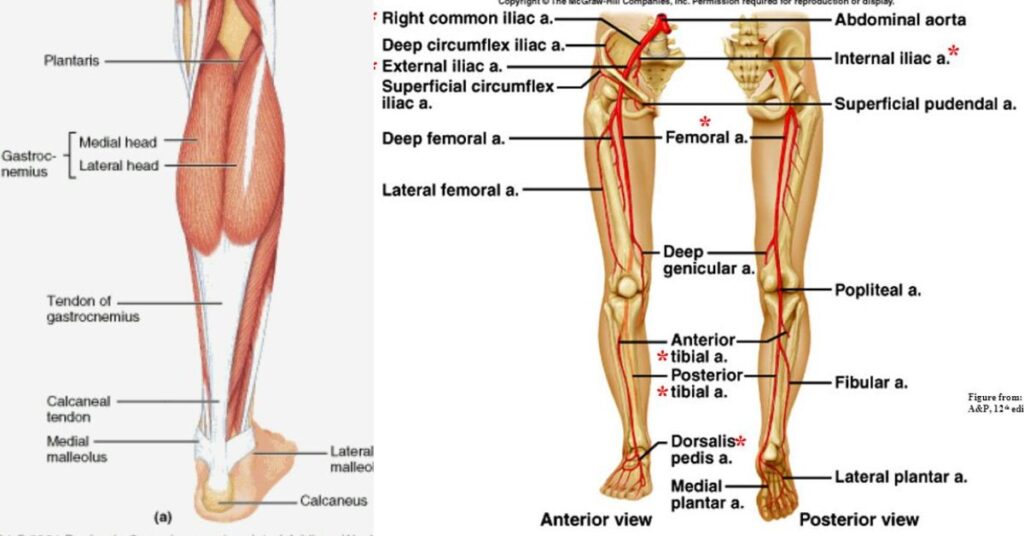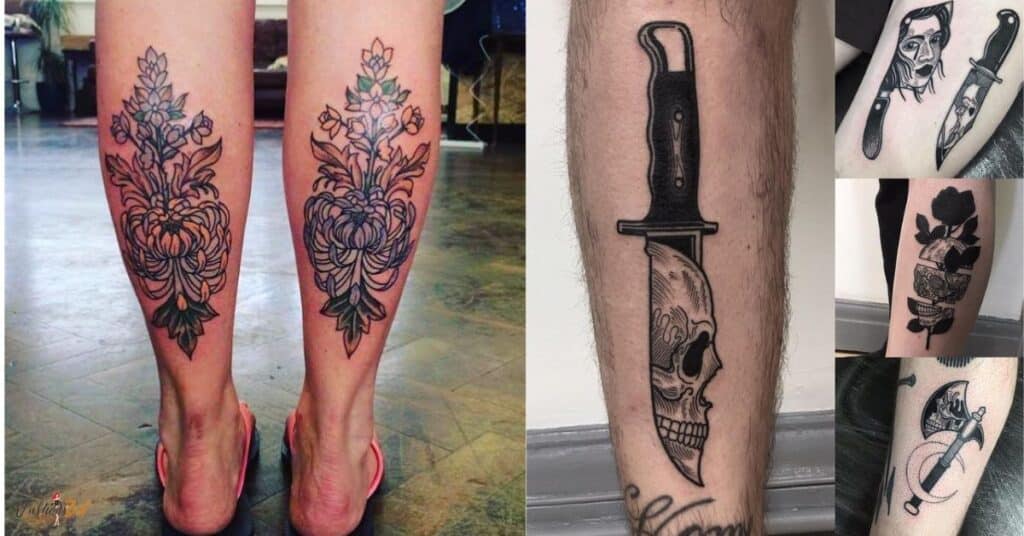Calf tattoos are designs inked on the lower part of the leg specifically on the calf muscle. These tattoos are often chosen for their versatility and ease of concealment. They can range from small symbols to intricate patterns offering a unique way to express oneself through body art.
Many wonder about the discomfort involved in getting inked on the calf. Understanding the experience and preparation for calf tattoos is essential. Let’s explore the realities behind the potential discomfort of calf tattoos.
Many people find them mildly uncomfortable but it varies. Factors like muscle density and individual pain tolerance play a role. Proper preparation and aftercare can help minimize any discomfort.
Calf Tattoos & The Calf Anatomy

Let’s talk about calf tattoos and the calf anatomy. The calves, filled with strong muscles support our movements like walking and running. Because of their muscle density calf tattoos are often chosen as they tend to cause less pain compared to other body areas.
Additionally, calf tattoos are easily concealed, making them a popular choice for those concerned about societal acceptance in workplaces where tattoos might be frowned upon. Understanding the calf anatomy helps in knowing what to expect during a tattoo session.
The calf muscles act like a cushion, reducing the impact of the tattoo needle. This often results in a more tolerable tattooing experience for many individuals. Moreover, the ability to hide calf tattoos provides flexibility for expressing oneself through body art without compromising professional appearances.
Does Getting A Calf Tattoo Hurt?
Calf tattoos often feature intricate designs that enhance their beauty. Pain levels during calf tattoo sessions can vary greatly from person to person. While some individuals may experience minimal discomfort others might find the process more painful.
Although anatomy suggests that calf tattoo pain should be minimal numerous factors contribute to individual pain experiences, including personal tolerance muscle density and other variables.
Age
Well, age can play a part. Some people think that as you get older you might feel less pain. But it’s not always true for everyone. Some older folks might handle pain better because they’ve been through a lot in life.
However, it’s different for each person no matter their age. So, whether calf tattoos hurt more or less due to age can vary from person to person.
Sex
Well, it can be different for boys and girls. Some people think that girls feel more pain than boys. But it’s not always true for everyone. Boys and girls have different bodies and they might feel pain differently.
Some girls might handle pain better because they’re used to it like when they have their periods. However, each person is unique, so whether calf tattoos hurt more or less because of your sex can vary from person to person.
Initial Expectations
Well, sometimes what you think can make a big difference. If you expect it to hurt a lot it might feel worse. But if you think it won’t hurt much it might not be so bad. This is because our minds are powerful.
If we worry too much about something it can make it seem worse than it really is. So, your initial expectations about the pain of getting a calf tattoo can affect how much it actually hurts.
Weight
Your weight can play a part in how much pain you feel. If you’re overweight or underweight, you might have different experiences. Some people with weight problems might have health issues that make tattoos more painful. But it’s not the same for everyone.
Your weight can affect how your body feels pain but each person is different. So, whether calf tattoos hurt more or less because of your weight can be different for each person.
Calf Muscle Density
The density of your calf muscles can make a difference. If you have strong calf muscles it might not hurt as much. That’s because the muscles can act like a cushion making the tattooing process less painful.
But if your calf muscles are less dense the bones might feel the needle more which could make it hurt more. So, whether calf tattoos hurt depends on how strong your calf muscles are and how much padding they provide.
How to Reduce Pain Before & During Your Tattoo Session?
Certainly, here are five simple tips on how to reduce pain before and during your tattoo session:
- Choose a Professional: Pick a trusted tattoo artist with experience and a clean studio. They can help you feel safe and calm during the session reducing anxiety.
- Consider Pain Relief: Some people find relief from pain by using topical numbing creams or taking painkillers before their appointment. Discuss options with your artist.
- Relaxation Techniques: Practice deep breathing or listen to calming music to help relax your body and mind before and during the tattooing process.
- Stay Sober: Avoid alcohol or drugs before your tattoo session, as they can increase bleeding and make you more sensitive to pain.
- Communicate: Don’t hesitate to communicate with your tattoo artist about any concerns or discomfort you’re feeling during the session. They can adjust their technique or take breaks if needed to help manage pain.
How To Reduce Calf Tattoo Pain After Your Tattoo Session?
Sure, here are some simple tips on how to reduce calf tattoo pain after your tattoo session:
Immediate Care:
- Gentle Cleaning: Use mild soap and water to gently wash your new tattoo. Avoid harsh scrubbing to prevent irritation.
- Pat Dry: After washing, pat your tattoo dry with a clean, soft towel. Avoid rubbing to prevent any damage to the delicate skin.
- Apply Topical Ointment: Once dry, apply a thin layer of recommended tattoo aftercare ointment or cream to keep the area moisturized and promote healing.
- Cover if Necessary: If your tattoo artist recommends it cover your tattoo with a clean non-stick bandage or gauze to protect it from dirt and friction. Follow your artist’s instructions for how long to keep it covered.
Topical Relief:
- Consider Painkillers: If you experience discomfort after your tattoo session you can take over the counter pain medication like acetaminophen or ibuprofen.
- Follow Dosage Instructions: Take the medication as directed on the packaging or as advised by a healthcare professional.
- Consult a Doctor if Needed: If pain persists or worsens seek advice from a healthcare provider for further guidance on managing your calf tattoo pain.
Pain Medication:
- Consider Painkillers: If you experience discomfort after your tattoo session you can take over the counter pain medication like acetaminophen or ibuprofen.
- Follow Dosage Instructions: Take the medication as directed on the packaging or as advised by a healthcare professional.
- Consult a Doctor if Needed: If pain persists or worsens seek advice from a healthcare provider for further guidance on managing your calf tattoo pain.
Long-Term Care:
Avoid Sun Exposure: Protect your tattoo from direct sunlight to prevent fading and damage by wearing clothing that covers it or applying sunscreen.
Keep it Clean: Practice good hygiene by gently washing the tattooed area with mild soap and water regularly to prevent infection.
Moisturize: Apply a recommended tattoo aftercare lotion or moisturizer to keep your skin hydrated and promote healing in the long run.
Read this blog: WHAT YOU NEED TO KNOW ABOUT YOUR FIRST MICROBLADING SESSION
How Long Do Calf Tattoos Heal?
Calf tattoos usually take about two to three weeks to heal on the surface. But complete healing both inside and out can take around three months. Healing time varies from person to person influenced by factors like infection blood circulation and nutrition. For a healthy healing process, it’s important to keep the tattoo clean avoid sun exposure and eat a balanced diet.
Infection
After getting a calf tattoo preventing infection is crucial for proper healing. Infection can prolong healing time and cause discomfort.
To avoid infection, keep the tattoo clean and dry and avoid touching it with dirty hands.
If you notice any signs of infection, such as excessive redness swelling or pus seek medical attention promptly for proper treatment.
Blood Circulation
Blood circulation plays a vital role in the healing process of calf tattoos. Good circulation ensures that essential nutrients and oxygen reach the tattooed area promoting faster healing.
Regular exercise and staying hydrated can help improve blood circulation aiding in the efficient healing of your calf tattoo.
Poor circulation on the other hand can delay healing, so it’s essential to maintain a healthy lifestyle to support the healing process.
Nutrition
Eating nutritious foods is important for the healing of calf tattoos. Nutrients like vitamins, minerals and proteins help the body repair itself.
A balanced diet with plenty of fruits, vegetables and lean proteins can support the healing process and reduce the risk of complications.
On the other hand, consuming unhealthy foods high in sugar and fat can slow down healing and increase the risk of infection.
Frequently Asked Question
Are calf tattoos more painful than tattoos in other areas?
Generally, calf tattoos are less painful than areas with less muscle, like the ribs or ankles.
Can I do anything to reduce the pain of a calf tattoo?
Yes, you can take painkillers use numbing creams or practice relaxation techniques.
Will my calf tattoo hurt more if I’m nervous?
It’s possible, as anxiety can make pain feel more intense.
Do certain factors affect how much a calf tattoo hurts?
Yes, factors like age, gender, muscle density and pain tolerance can influence pain levels.
How long will the pain from a calf tattoo last?
Pain usually subsides within a few days to a week but it varies for each person.
Conclusion
In conclusion, whether calf tattoos hurt varies from person to person. Factors like pain tolerance, age, gender and muscle density all play a role in how much discomfort one might feel during a tattoo session. While some individuals may find calf tattoos to be relatively painless others may experience more significant discomfort.
However, it’s essential to remember that temporary pain often comes with the territory of getting a tattoo and for many, the end result is worth the brief discomfort. Ultimately, if you’re considering getting a calf tattoo, it’s crucial to prepare yourself mentally and physically for the experience.
Communicate openly with your tattoo artist about any concerns or preferences you have and consider employing pain reducing techniques such as numbing creams or relaxation methods. With proper preparation and aftercare, you can minimize discomfort and enjoy the process of getting a calf tattoo ultimately cherishing the meaningful artwork you’ll carry with you for years to come.

David a seasoned professional with 5 years of expertise in the fashion industry, brings creativity and passion to our website. Explore his rich background and insights in the dynamic world of fashion.







